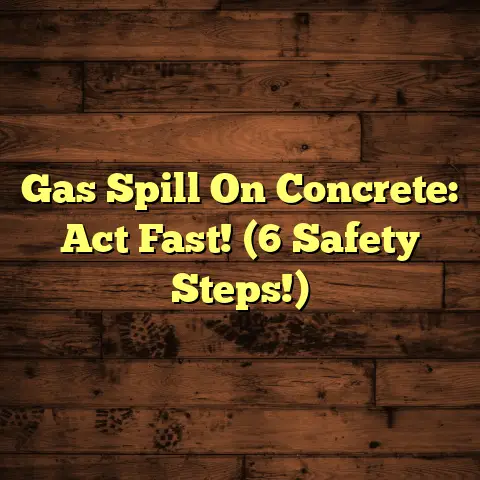Gas Spill In Garage: Act Fast! (9 Hazards!)
Imagine this: You’re tinkering in your garage, maybe tuning up your classic car, when whiff! You catch a strong smell of gasoline. It’s faint at first, but then it grows, sharp and unmistakable. A shiver runs down your spine.
It’s a gas spill. And in a space as confined and potentially volatile as your garage, you’ve just stepped into a danger zone. Think of it like that scene in “Back to the Future” when Doc Brown’s lab almost blows up – that’s the kind of urgency we’re dealing with here!
As a flooring contractor, you might be thinking, “What does this have to do with me?” Well, everything! Garages often have concrete floors, and gasoline can damage and stain them. Plus, the fumes can seep into your home. More importantly, I want you and your family to be safe.
I’ve seen firsthand the damage a gas spill can cause, not just to property, but to people’s lives. So, let’s dive into understanding the risks and how to handle this hazardous situation.
Section 1: Understanding the Nature of Gasoline
Okay, let’s get down to basics. What is gasoline, really?
It’s a complex mixture of hydrocarbons, refined from crude oil. We use it primarily as fuel for internal combustion engines in cars, lawnmowers, and other equipment. In garages, you’ll typically find it stored in portable gas cans for these purposes.
I’ve noticed some folks store gas in improper containers, like old milk jugs. Big mistake! Gasoline can dissolve certain plastics, leading to leaks and spills. Always use approved, tightly sealed gasoline containers.
Now, here’s the scary part: gasoline is highly flammable. Its low flash point means it evaporates quickly, creating vapors that can easily ignite. These vapors are heavier than air, so they tend to sink and accumulate in low-lying areas like garage floors, creating a dangerous concentration.
Did you know that just one gallon of gasoline has the explosive potential of several sticks of dynamite? That’s something to keep in mind!
Section 2: Identifying the Signs of a Gas Spill
How do you know you have a gas spill? It’s not always obvious.
The most common sign is the unmistakable smell of gasoline. It’s a pungent, sharp odor that’s hard to miss. If you smell it, don’t ignore it!
Visually, you might see a puddle of liquid on the floor. Gasoline is typically clear or slightly yellowish. It may also leave a rainbow-like sheen on surfaces.
But what if it’s a small leak? Maybe a slow drip from a fuel line. These can be harder to detect. Look for stains on the floor or around fuel storage areas.
A minor spill might just be a few drops while filling your lawnmower. A significant leak could be a ruptured gas can or a broken fuel line. The difference is in the volume and the speed of the leak. A large, rapidly spreading puddle is a major red flag.
I always tell my clients to be extra cautious around their vehicles and fuel storage. Regular inspections can help catch leaks early.
Section 3: Immediate Actions to Take After a Spill
Time is of the essence when it comes to a gas spill. Every second counts.
1. Evacuate Immediately: Get everyone out of the garage, including pets. Don’t hesitate. Just get out!
2. No Sparks! This is crucial. Don’t turn on or off any lights or appliances. Don’t use your cell phone in the garage. Any spark can ignite the vapors.
3. Ventilate: If it’s safe to do so without creating sparks (e.g., manually opening a garage door), ventilate the area by opening doors and windows to allow the fumes to dissipate.
4. Call for Help: Contact your local fire department or emergency services immediately. Let them know you have a gas spill and provide your location.
5. Stay Away: Keep people and pets away from the area until emergency responders arrive and give the all-clear.
Remember, your safety is the top priority. Don’t try to be a hero and clean up the spill yourself if it’s significant. Leave it to the professionals.
Section 4: Hazard #1 – Fire Risk
Let’s talk about the most obvious danger: fire.
Gasoline vapors are incredibly flammable. A single spark from a light switch, a static electricity discharge, or even a running engine can ignite them.
Once ignited, a gasoline fire spreads rapidly and produces intense heat. It can quickly engulf your garage and spread to your home.
According to the National Fire Protection Association (NFPA), garages are a common location for home fires, and flammable liquids like gasoline are a significant contributing factor.
I’ve personally seen the aftermath of garage fires caused by gas spills. The devastation is heartbreaking. Vehicles are destroyed, tools are melted, and the structural damage to the garage can be extensive.
That’s why fire prevention is paramount. Always store gasoline properly, handle it with care, and address any spills immediately.
Section 5: Hazard #2 – Explosion Potential
Even more terrifying than a fire is the risk of an explosion.
When gasoline vapors mix with air in the right concentration, they create an explosive mixture. If this mixture is ignited, it can result in a powerful explosion.
The confined space of a garage amplifies the force of an explosion. The pressure wave can shatter windows, collapse walls, and cause serious injuries.
Factors that contribute to the risk of explosion include the amount of gasoline spilled, the ventilation in the garage, and the presence of ignition sources.
Think of it like this: gasoline vapors are like tiny bombs waiting to be triggered. Don’t give them the chance!
Section 6: Hazard #3 – Toxic Fumes
Even if a gas spill doesn’t ignite or explode, it can still pose a serious health risk due to toxic fumes.
Gasoline contains various chemicals, including benzene, toluene, and xylene, which can be harmful when inhaled.
Exposure to gasoline fumes can cause a range of symptoms, including:
- Headaches
- Dizziness
- Nausea
- Irritation of the eyes, nose, and throat
- Difficulty breathing
Prolonged or high-level exposure can lead to more serious health effects, such as:
- Neurological damage
- Respiratory problems
- Cancer (especially leukemia, linked to benzene exposure)
I know a guy who worked in a gas station for years and developed chronic respiratory issues. He always attributed it to the constant exposure to gasoline fumes.
Always ensure proper ventilation when handling gasoline, and wear a respirator if you’re working in an area with high concentrations of fumes.
Section 7: Hazard #4 – Slips and Falls
It might seem less dramatic than fire or explosion, but slips and falls are a real risk associated with gas spills.
Gasoline is a slippery substance. When spilled on a garage floor, it creates a hazardous surface that can easily cause someone to lose their footing.
According to the National Safety Council, falls are a leading cause of injuries in the United States, and slippery surfaces are a major contributing factor.
Imagine rushing to clean up a spill and slipping on the gasoline. You could suffer a broken bone, a concussion, or other serious injuries.
Always wear appropriate footwear with good traction when working in your garage, and clean up spills immediately to prevent slips and falls.
Section 8: Hazard #5 – Environmental Impact
Gas spills aren’t just a threat to your property and health; they can also harm the environment.
When gasoline spills onto the ground, it can contaminate the soil and groundwater. This can pollute drinking water sources and harm plants and animals.
Gasoline contains chemicals that can persist in the environment for years, causing long-term damage.
Furthermore, improper disposal of gasoline-soaked materials can also contribute to environmental pollution.
Many municipalities have strict regulations regarding the handling and disposal of gasoline. Failing to comply with these regulations can result in fines and legal penalties.
Always dispose of gasoline-soaked materials properly, following local guidelines. Contact your local environmental agency for information on proper disposal methods.
Section 9: Hazard #6 – Damage to Property
Gasoline is a corrosive substance that can damage various materials commonly found in garages.
Spilled gasoline can damage the paint on your car, dissolve rubber components, and corrode metal surfaces.
It can also damage tools, equipment, and other items stored in your garage.
Concrete floors are particularly vulnerable to gasoline spills. The gasoline can penetrate the concrete, causing staining and weakening the material.
The cost of repairing or replacing damaged items can be significant.
I’ve seen garages where the concrete floor is so stained and damaged from years of gas and oil spills that it needs to be completely replaced.
Protect your property by preventing spills and cleaning them up promptly. Consider sealing your concrete floor to make it more resistant to spills.
Section 10: Hazard #7 – Chemical Reactions
Garages are often filled with various chemicals, such as cleaning products, paints, and solvents. Gasoline can react with these chemicals, creating additional hazards.
For example, mixing gasoline with bleach can produce toxic fumes.
Gasoline can also react with certain plastics, causing them to degrade and release harmful chemicals.
Always store chemicals properly and avoid mixing them with gasoline. Read the labels carefully and follow the manufacturer’s instructions.
Section 11: Hazard #8 – Firefighter and Rescuer Risks
When you call emergency services to respond to a gas spill, you’re putting firefighters and other rescuers at risk.
They face the same hazards as you, including the risk of fire, explosion, and exposure to toxic fumes.
They also face the added challenge of working in a chaotic and unpredictable environment.
Firefighters are trained to handle hazardous materials, but they rely on accurate information to assess the risks and take appropriate precautions.
Provide them with as much information as possible about the spill, including the amount of gasoline spilled, the location of the spill, and any other potential hazards.
Section 12: Hazard #9 – Psychological Effects
Experiencing a gas spill can be a traumatic event that has lasting psychological effects.
The fear of fire, explosion, and health risks can cause anxiety, stress, and even post-traumatic stress disorder (PTSD).
The disruption to your life and the financial burden of cleanup and repairs can also contribute to psychological distress.
If you’ve experienced a gas spill and are struggling with anxiety or stress, don’t hesitate to seek professional help. A therapist or counselor can provide support and guidance.
Conclusion:
A gas spill in your garage is no joke. It’s a serious situation that demands immediate action. From the immediate threat of fire and explosion to the long-term risks of toxic fumes and environmental damage, the hazards are numerous and potentially devastating.
I’ve walked you through the nine biggest dangers: fire risk, explosion potential, toxic fumes, slips and falls, environmental impact, property damage, chemical reactions, risks to first responders, and the psychological toll it can take.
By understanding these risks and knowing how to respond, you can protect yourself, your family, and your property. Act fast, stay safe, and remember, when in doubt, call the professionals. It’s always better to be safe than sorry.





